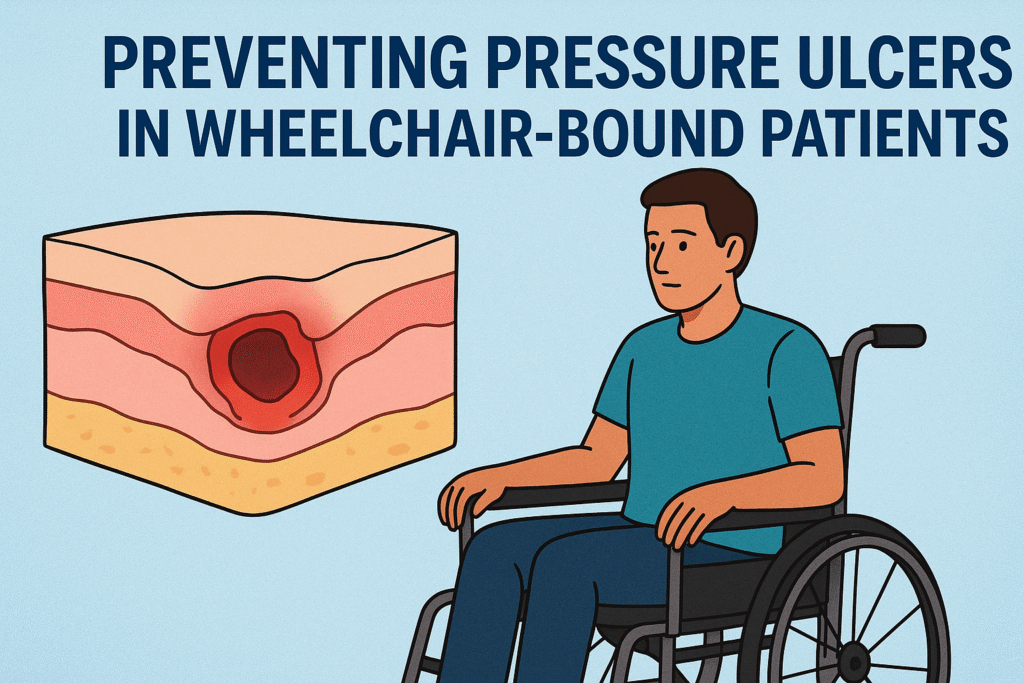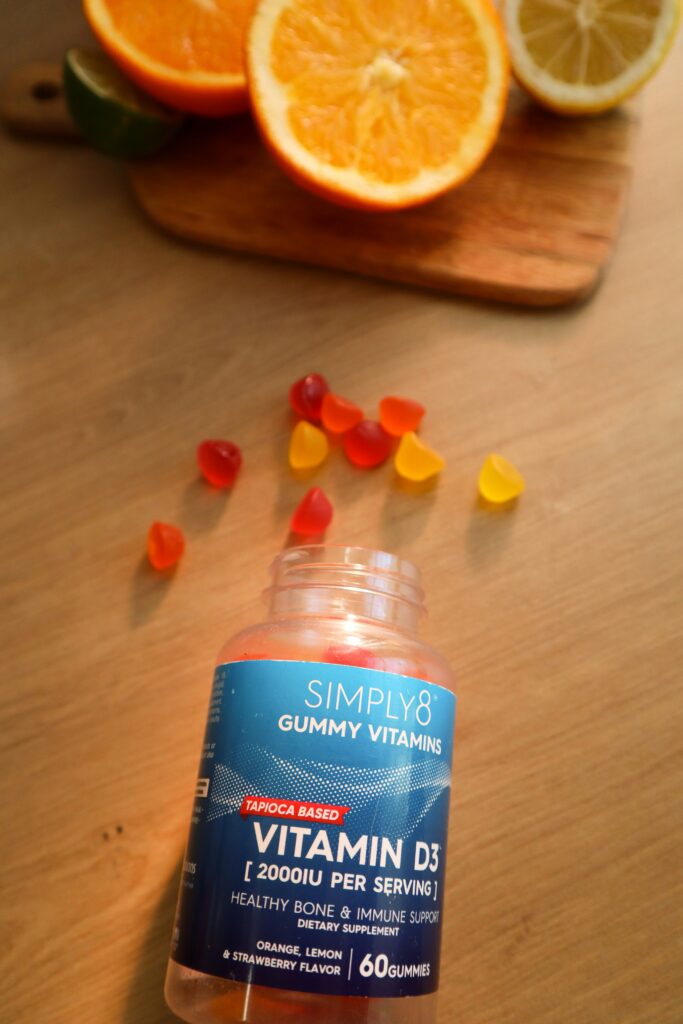
⚠️ Affiliate Disclaimer: This post may contain affiliate links, which means I may earn a small commission — at no extra cost to you — if you make a purchase through one of these links. I only recommend products or services I genuinely trust and believe can provide value. Thank you for supporting My Medical Muse!
7 Proven Ways to Prevent Pressure Ulcers in Wheelchair-Bound Patients
Preventing Pressure Ulcers in Wheelchair-Bound Patients: A Complete, Practical Guide for Caregivers & Patients
For many wheelchair-bound individuals, the daily challenge isn’t just limited mobility, it’s protecting their skin from a silent but serious threat- pressure ulcers, also called bedsores or pressure injuries, these wounds form when prolonged pressure on the skin cuts off blood supply to the underlying tissues.
What makes them especially dangerous is their ability to develop quietly and progress quickly. A spot that looks slightly red in the morning can, if left unaddressed, turn into a deep wound by the end of the week. Beyond the pain and discomfort, advanced pressure ulcers can lead to serious infections, lengthy hospital stays, and even life-threatening complications.
Yet here’s the hopeful truth, most pressure ulcers are entirely preventable with the right combination of daily habits, proper equipment, attentive care, and early detection, you can dramatically reduce the risk, whether you’re the person in the wheelchair or the caregiver providing support.
In this guide, we’ll break everything down in clear, step-by-step terms:
- How and why pressure ulcers form
- The key risk factors every wheelchair user should know
- How to spot early warning signs before real damage occurs
- Proven, real-world prevention strategies, from choosing the right cushion to creating a daily skin-check routine
- Special considerations for those with spinal cord injuries, diabetes, or advanced age
Our goal is simple, to give you the knowledge and tools to protect skin health, maintain comfort, and preserve quality of life, every single day. Whether you’re a healthcare professional, a devoted family member, or someone navigating wheelchair life yourself, this guide will equip you with practical solutions you can start using today.
Understanding Pressure Ulcers
Before you can prevent pressure ulcers, it’s essential to understand what they are, why they develop, and how to recognize them early. For wheelchair-bound individuals, this knowledge can mean the difference between a small, treatable skin irritation and a deep, painful wound that requires months of care.
What Are Pressure Ulcers?
Pressure ulcers are localized injuries to the skin and the tissue beneath it, typically occurring over areas where the bone lies close to the skin. They are caused by three main forces:
- Prolonged pressure: Continuous force that squeezes blood vessels shut, cutting off oxygen and nutrient supply to the skin.
- Friction: Repeated rubbing of the skin against clothing, bedding, or wheelchair cushions, which can wear away the skin’s protective layer.
- Shear: When layers of skin slide over one another, often during repositioning, causing deeper tissue injury beneath the skin.
In wheelchair users, the most common sites for pressure ulcers include:
- Buttocks (ischial tuberosities): the primary weight-bearing area when seated
- Tailbone (sacrum/coccyx): especially for those who slouch or lean back frequently
- Back of thighs: from the seat edge pressing into the skin
- Shoulder blades: in users with poor posture or ill-fitting wheelchairs
- Elbows: when resting arms on hard surfaces for long periods
If these areas experience unrelieved pressure, skin cells begin to die within hours. Left untreated, a small reddened patch can progress into a deep, open wound that exposes muscle or bone.
Why Wheelchair Users Are at Higher Risk
While anyone can develop a pressure ulcer, wheelchair users face unique challenges that increase their vulnerability:
- Constant sitting pressure: The seated position places ongoing weight on a few small areas, limiting blood flow.
- Reduced sensation: Conditions like spinal cord injuries or peripheral neuropathy may prevent a person from feeling discomfort, so early warning pain signals are missed.
- Limited mobility: Some users can’t independently shift or reposition to relieve pressure.
- Moisture exposure: Sweat, spilled fluids, or incontinence can weaken skin, making it more prone to breakdown.
- Poor nutrition and hydration: Inadequate protein, vitamins, and fluids slow skin repair and make it more fragile.
- Ill-fitting wheelchairs or cushions: Uneven support can concentrate pressure in high-risk spots.
- Muscle atrophy: Loss of muscle padding over bony areas increases direct pressure on the skin.
If you use a wheelchair, your skin is working harder than you realize. It needs extra protection and daily attention.
The Stages of Pressure Ulcers
Recognizing the stage of a pressure ulcer is vital because it guides treatment and prevention steps.
Stage | Skin Appearance | Tissue Damage |
Stage 1 | Red, warm, or discolored skin that does not turn white (blanch) when pressed. May feel firm or softer than surrounding skin. | Surface irritation — only the top skin layer is affected. |
Stage 2 | Partial-thickness loss of skin. May appear as a shallow open sore, pink wound bed, or intact/ruptured blister. | Damage to the epidermis and dermis. |
Stage 3 | Full-thickness skin loss with visible fat tissue. The wound may have slough (yellow tissue) but no exposed bone, tendon, or muscle. | Extends into subcutaneous tissue. |
Stage 4 | Severe wound exposing muscle, tendon, or bone. Often has slough or eschar (blackened dead tissue). | Extensive tissue destruction. |
Important early warning signs:
- Persistent redness or purple/blue discoloration in dark skin tones
- Skin that feels unusually warm or cool compared to surrounding areas
- Changes in skin texture, firmer, softer, or spongier
- Tenderness or swelling, even without an open sore
Stage 1 pressure ulcers can heal quickly with prompt action, but once skin breaks, recovery time increases dramatically. Always treat early redness as urgent.
Extra note for caregivers:
Dark skin tones can make redness harder to see. In these cases, rely on touch (temperature changes, firmness) as much as sight to detect early issues.
2. Core Principles of Prevention
Preventing pressure ulcers is not about one single trick, it’s about combining consistent daily habits with the right equipment and support. These habits rest on three main pillars:
- Reducing and redistributing pressure
- Protecting and monitoring skin health
- Maintaining overall wellness through good nutrition, hydration, and lifestyle
1. Regular Pressure Relief:
Constant pressure is the main culprit behind pressure ulcers. The longer skin and underlying tissues are compressed, the higher the risk of injury.
What to do:
- Shift weight at least every 15-30 minutes, holding each shift for 30-90 seconds to allow blood flow to return.
- Use simple pressure relief techniques:
- Forward lean: Lean your chest toward your knees.
- Side lean: Shift weight onto one hip at a time.
- Seated push-up: Push down on the armrests to lift your body slightly.
- Forward lean: Lean your chest toward your knees.
- If you can’t reposition on your own, ask a caregiver to perform wheelchair tilts or assist with transfers to a different surface.
- Use a phone alarm or timer to remind yourself if sensation is reduced and you can’t rely on discomfort as a signal.
Studies show that repositioning every 15 minutes can cut the incidence of ulcers in high-risk individuals by over 60%.
2.Use of Pressure-Relieving Cushions
A quality cushion isn’t just for comfort, it’s a vital tool for distributing weight evenly and preventing dangerous pressure points.
Main cushion options:
- Foam cushions: Lightweight, affordable, but may compress over time, losing effectiveness.
- Gel cushions: Good at distributing weight and reducing heat, but heavier and less portable.
- Air cushions: Excellent adjustability for maximum pressure relief, often best for very high-risk users.
- Hybrid cushions: Combine foam with gel or air for both stability and protection.
Best practice:
- Have a seating assessment by an occupational therapist to ensure the cushion fits your body size, weight, and posture.
- Check and maintain cushions daily, ensure air cushions are properly inflated and foam/gel models are free from cracks or leaks.
3. Skin Care and Inspection
Skin is the body’s first defense. Damage often begins before you see an open wound, so early detection is key.
Daily skin check routine:
- Inspect all high-risk areas at least twice a day, morning before dressing and evening before bed.
- Use a hand mirror or ask a caregiver to check hard-to-see areas like the tailbone or back of thighs.
Pay attention to:
- Persistent redness or discoloration
- Swelling or localized warmth
- Unusual firmness or softness
- Small tears, cracks, or blisters
- Persistent redness or discoloration
Hygiene tips:
- Keep skin clean and dry.
- Use pH-balanced cleansers, avoid harsh soaps that strip protective oils.
- Pat dry rather than rubbing to prevent friction damage.
- Apply barrier creams on areas exposed to moisture from sweat or incontinence.
4. Nutrition for Skin Health
Healthy, well-nourished skin is more resistant to breakdown and heals faster.
Key nutrients:
- Protein: repairs tissue (lean meats, eggs, legumes, dairy).
- Vitamin C: boosts collagen formation (citrus fruits, bell peppers, berries)
- Zinc: supports wound healing (meat, seafood, whole grains)
- Hydration: keeps skin elastic and resilient (1.5-2 liters water/day unless medically restricted)
Poor nutrition and dehydration can turn a small skin irritation into a serious ulcer in days.
5. Moisture and Temperature Control
Damp skin breaks down faster, and excessive heat increases sweating, which can trap moisture against the skin.
Moisture control strategies:
- Wear breathable, moisture-wicking clothing.
- Change damp clothes immediately after sweating or accidents.
- Use absorbent pads or briefs if incontinent and change them promptly.
- Avoid sitting in sweat-soaked clothing after exercise or therapy.
- Keep living spaces cool and well-ventilated to minimize overheating.
Prevention isn’t complicated, but it does require consistency. If you integrate pressure relief, good skin care, proper nutrition, and moisture control into your daily routine, you drastically lower your chances of developing pressure ulcers.
Practical Prevention Plan
A strong prevention routine is easiest to maintain when it’s built into your daily schedule. Here’s a realistic plan for wheelchair-bound individuals and their caregivers:
Morning Routine
- Full skin inspection before getting into the wheelchair, focus on tailbone, buttocks, back of thighs, and any other pressure-prone areas.
- Apply barrier cream to protect high-risk spots from moisture and friction.
- Check wheelchair cushion for proper inflation or positioning; adjust straps, footrests, and backrest for comfort and posture support.
Daytime Habits
- Shift weight every 15-30 minutes: use forward leans, side leans, or assisted tilts.
- Check skin after exercise, outdoor activities, or long transfers.
- Stay hydrated: sip water throughout the day.
- Avoid hard surfaces: always use a cushion when sitting away from the wheelchair.
Evening Routine
- Skin inspection before bed address any redness or irritation immediately.
- Change and launder any damp or soiled clothing.
- Light massage around (not directly on) bony areas to promote blood circulation.
Special Considerations for High-Risk Patients
Some groups require extra vigilance because their risk is significantly higher.
1. Spinal Cord Injury (SCI)
- Loss of sensation may prevent pain alerts, use timers or phone reminders for pressure relief.
- Reassess wheelchair fit regularly, posture and body shape can change over time.
2. Elderly Wheelchair Users
- Fragile skin tears easily, avoid adhesive tapes and rough fabrics.
- Maintain a stable room temperature to prevent chills or excessive sweating.
3. Patients with Diabetes
- Inspect feet and lower legs daily, ulcers can develop unnoticed.
- Control blood sugar to speed healing and improve skin resilience.
When to Seek Medical Attention
Contact a healthcare provider promptly if you notice:
- Redness that doesn’t fade after relieving pressure
- Blisters, open sores, or skin tears
- Foul-smelling or discolored drainage
- Signs of infection- fever, swelling, pus, or spreading redness
Why act fast? Early treatment prevents deeper tissue damage, speeds recovery, and reduces the risk of hospitalization.
Role of Caregivers and Healthcare Professionals
Preventing pressure ulcers is often a team effort:
- Caregivers: trained in safe transfers, cushion adjustments, and skin checks.
- Occupational therapists: assess wheelchair fit, recommend cushions and seating modifications.
- Nurses: provide wound care and teach dressing techniques.
- Dietitians: design meal plans that support skin healing and overall health.
Emerging Technologies for Prevention
Advances in assistive technology are making prevention easier:
- Smart wheelchair cushions: detect pressure build-up and alert users to shift.
- Wearable skin temperature sensors: identify early inflammation before visible damage.
- Custom 3D-printed cushions: designed to perfectly match body contours for optimal weight distribution.
Quick Reference: Key Prevention Strategies
Strategy | Frequency | Notes |
Weight shifts | Every 15–30 minutes | Forward lean, side lean, push-ups, or assisted tilt |
Skin inspection | Twice daily | Use a mirror or caregiver assistance |
Cushion check | Daily | Ensure proper inflation, shape, and placement |
Hydration | Ongoing | 1.5-2 L/day unless medically restricted |
Nutrition | Daily | High protein, vitamin C, zinc-rich foods |
Moisture control | As needed | Change damp clothing and briefs promptly |
9. Conclusion
Preventing pressure ulcers in wheelchair-bound patients is not a matter of luck, it’s the result of daily, intentional care. Every weight shift, every skin check, every glass of water, and every adjustment to your cushion adds up to a powerful shield against a problem that can be both painful and life-altering.
Think of prevention as an investment, the few minutes you spend today could save you weeks or months of wound care tomorrow. The cost in time and effort is small, but the rewards, preserved mobility, comfort, independence, and dignity are priceless.
Whether you’re the one in the wheelchair, the caregiver providing support, or the healthcare professional guiding the process, you have the power to make a lasting difference. By combining pressure relief, proper seating, vigilant skin monitoring, balanced nutrition, and moisture control, you can keep skin healthy and strong.
Pressure ulcers don’t have to be part of wheelchair life. Start today, stay consistent, and protect not just the skin but the quality of life it helps you maintain.
👩⚕️ Need Personalized Health Advice?
Get expert guidance tailored to your unique health concerns through MuseCare Consult. Our licensed doctors are here to help you understand your symptoms, medications, and lab results—confidentially and affordably.
👉 Book a MuseCare Consult NowRelated Post You Might Like:
- Can Intermittent Fasting Help Type 2 Diabetes? 9 Powerful Facts
- 10 Sneaky Symptoms of Prediabetes in Women Over 40 You Can’t Ignore
- 10 Proven Tips on How to Interpret Hemoglobin A1c Levels Accurately
- Scalp Psoriasis vs Dandruff: 10 Expert Ways to Know the Difference Fast
- 13 Powerful Ways Zinc Deficiency Wrecks Your Skin and Immunity (Backed by Science)


